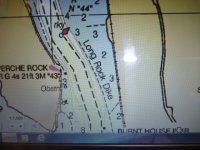No matter how good we are, or how good we think we are, there comes a time when a series of events can lead to an accident. This happened to me last Friday. I was on the Thames River near high tide, traveling around 15 mph. I passed between the red and green cans located before a slight bend in the river to my right. My passenger, who had been using his iPhone navigation app to point out river obstructions and turns over the past hour decided to shut it off to save battery power just at that point in time. I got a crick in my back so I stood up while ensuring I was aligned with the two cans over 100 yards ahead, and keeping my eyes on them. Bam! Bam! Bam! Bam! Bam! Bam! Bam! Bam!...My skeg hit rock after rock. I looked down, and the rocks were approximately 8 to 10 inches below the water. The propeller was twisted beyond all repair and on the following dat discovered that my hull slid over rocks. With a look of shock on my face, I could not understand how it happened. I looked at my Raymarine chart, and there were no rocks marked, even though I went slightly out of the channel. As it turned out, I hit a dike, which was concealed by high tide. Frankly, marker buoys should be placed at the turn, and not before it. Fortunately, it was not a hull impact, but nevertheless, the rocks scraped through the gelcoat revealing the first layer of fiberglass across the center chine. Thank God that the Marinaut (as well as C- Dorys) have a shallow draft or else it would have been a far more serious calamity. As I said, the hull did not impact the rocks, but slid over them, so there was no major structural damage. I've posted photos of the damage in my album. One can say that this was the first Marinaut 215 accident. A series of seeming meaningless coincidences all contributed to this accident, in a manner consistent with the movie, "Fate Is The Hunter."
My main motor was unusable, but we got back to home port 20 miles away in less than 3 hours. I'll post specifics on this under a separate topic. Now to re-enter the single vs. twins debate, if I had twin engines on my Marinaut, or any other boat for that matter, both engines would have been taken out. My auxilliary was high and dry, and most importantly -- usable.
One of the workers at the marina said that it was a good thing I didn't hole the boat. Actually, had I holed the boat, I believe that the sealed inner sole would have kept the water from filling the boat in this type of accident.
Incidentally, when I climbed under the hull to look at the damage, I was surprised at how substantial the center chine is. It really protected the hull.
Rich
Here are the accident photos
http://www.c-brats.com/modules.php?...ame=gallery&file=index&include=view_album.php
My main motor was unusable, but we got back to home port 20 miles away in less than 3 hours. I'll post specifics on this under a separate topic. Now to re-enter the single vs. twins debate, if I had twin engines on my Marinaut, or any other boat for that matter, both engines would have been taken out. My auxilliary was high and dry, and most importantly -- usable.
One of the workers at the marina said that it was a good thing I didn't hole the boat. Actually, had I holed the boat, I believe that the sealed inner sole would have kept the water from filling the boat in this type of accident.
Incidentally, when I climbed under the hull to look at the damage, I was surprised at how substantial the center chine is. It really protected the hull.
Rich
Here are the accident photos
http://www.c-brats.com/modules.php?...ame=gallery&file=index&include=view_album.php

